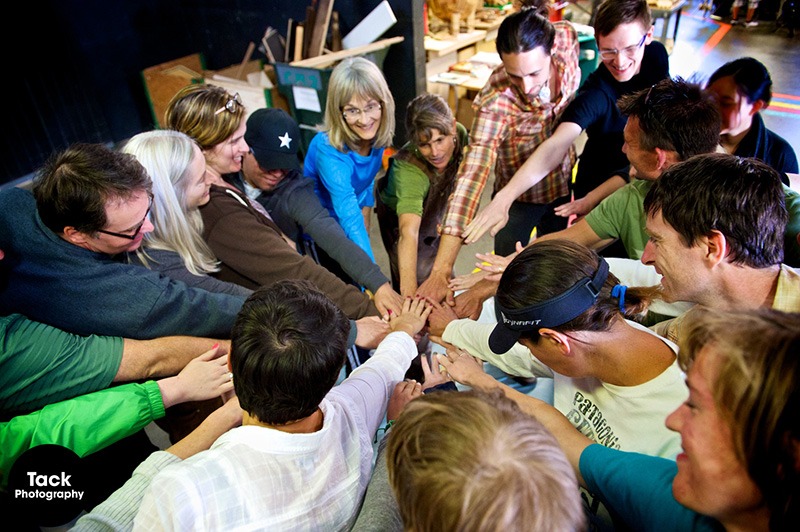
A big goal of our Tiny House Basics Workshops is to help attendees design and build a tiny house that fits them, and to do it right the first time. We answer the questions people have right now, AND give them the tools and resources they need to answer the questions they don’t know they have until they’re staring at a snarl of electrical wires, or reading their area’s building codes.
At the end of our two-day workshops we get fantastic feedback from folks, but recently we wondered how beneficial our workshops are to those who decide to move forward with building their dream. We wanted to know: what is the value of the information they got that weekend once they started designing, building, moving, and finding home?
We reached out to some folks who we met at PAD workshops with just a tiny house dream in their heads, and asked how the workshop experience influenced their process. We got this amazing response from our friend Kate Goodnight, a meticulous builder and thoughtful writer, and just had to share it.
“Building a tiny house is no small endeavor. Houses don’t just miraculously stand on their own. They need to be framed just so and be protected from the elements. They need to breathe and stay warm. They need to be wired and plumbed safely. Stick them on wheels and you have a whole new set of complications to keep your house from shooting off the trailer, bits flying willy-nilly in a trail of destruction down the road.
To be able to pull off building a tiny house, you need a lot of experience to draw on. If, like me, you don’t have it yourself, you need to find it elsewhere. The PAD workshops I attended were just the right balance of enthusiastic support; pragmatic advice about very real issues like zoning, codes and how to construct a safe and sound house; and a wellspring of experience and expertise, all very helpful for planning, building and living long-term in a tiny house.

While there’s a ton of information online, the workshop was what I needed to understand how to safely secure the house to the trailer, how to build a rainscreen wall, and frame the house properly. Learning about the building science behind moisture control and ventilation, and figuring out what is and isn’t important to my lifestyle needs, helped me to come up with creative design solutions like having a separate bathhouse, something I would never have considered before but now seems like a viable option for tiny house living.
I also learned where I could cut costs and when it is critical to buy new. I learned to think about building materials from both a personal and environmental health perspective. How do I design a house tailored specifically to my needs? And what are those needs, really? The workshop was great fodder for thinking about the type of life I want to lead, who I want to be, and how a tiny house can help me get there.
Tiny houses are getting a lot of attention these days, and you see people bending over backwards to figure out how they can live tiny and still have it all, squeezing a big house mentality and functionality into a tiny space. PAD takes an alternative approach, asking participants to wonder: what do you need to live, and what can you live without? Can you live with fewer things and find more meaning in your life? Starting from this simple premise and designing your house around what you really need to be happy and fulfilled leads to a very different kind of house.

I’m convinced that working through this process is why my heart soars every time I step into my house. Even though it’s not finished yet, the choices I’ve made in terms of roof style, open layout, window placement, colors and materials all feel like an extension of myself. I really appreciated that the course was not just, “Yay tiny houses,” but gave me the tools to make critical decisions during the planning stages, to solve problems that come up during construction to make sure my house ends up safe and sound, and to understand what my options are for parking and creating the kind of community I want to live in.
For someone like me who wants to see the big picture, who wants to go into a complicated endeavor with eyes wide open, the PAD workshop provided the critical building science, zoning, and code information, along with the pragmatic realities of what I was getting myself into. That knowledge, conveyed by teachers with years of experience in building and living tiny, has shaped not only how I have designed and constructed Naj Haus, but has ultimately led me to make big life changes, including quitting my job and moving back to the Northwest. More importantly, it’s set me off on a course of exploring what is meaningful to me and what I want in terms of community, relationships, and a creative life lived closer to nature. Kind of crazy to think one weekend could have such an inspirational impact, but it did!”
Kate, we’re misty-eyed over here! Follow along with Kate’s build at Najhaus.com, and look at our upcoming workshops if you’re wondering what a tiny house workshop could do for you.


Comments are closed.